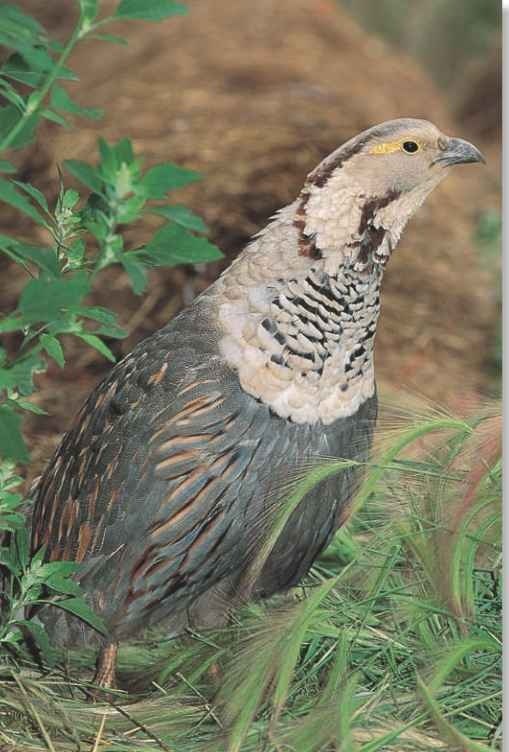ORDER
Galliformes
FAMILY
Phasianidae
GENUS & SPECIES
KEY FEATURES
Flies down hillsides f in pairs or groups in the early morning to L search for water
• Spends the day feeding during its climbing ascent back to its hillside roost
• Coloration blends well with the environment for excellent camouflage against predators, such as snow leopards
WHERE IN THE WORLD?
Found on the open slopes of the western Himalayas of China; also the Tien Shan mountains of Russia and China, the Pamir range of Russia and mountains of Tadjikistan and Afghanistan
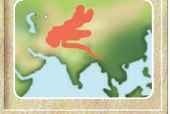
Lifecycle
This noisy gamebird will try to outrun its pursuers, scurrying between boulders before resorting to flying, when it will soar downhill on broad wings.
HABITAT
The Himalayan snowcock inhabits the rocky alpine slopes of western and central China. In the summer; the bird resides in the western Himalayas — Kashmir; Laddaakh, Punjab, Garhwal, Kumaos,
western Nepal — between 13,000-18,000′. The snowcock descends to elevations of 8,000′ or lower during severe winters.
Himalayan hideaway The snowcock’s home is beautiful but isolated.
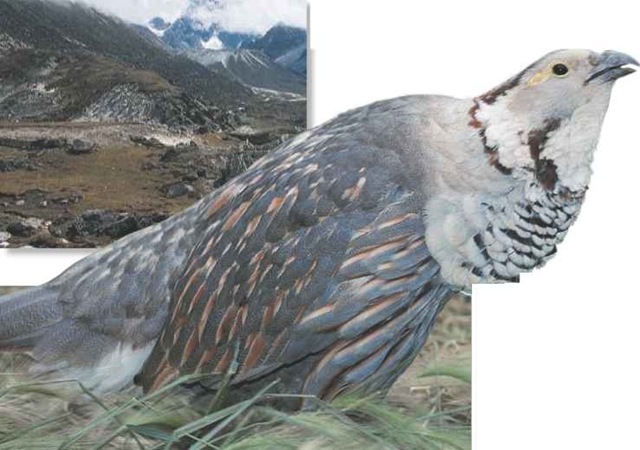
BREEDING
During the breeding season, from April to June, the male snowcock is especially noisy, repeating a prolonged whistle as he stands on a rock or mound. The monogamous male pursues the female in a crouched position with his tail held vertically in the air: The courtship ceremony continues as he walks around the female with his head lowered, making periodic dashes for a rock or mound. While mating, the female gets so badly mauled by the male that her crown is often left bare of feathers and her skin bruised and red.
The female scratches out a nest hollow among stones and boulders in the open or under a ledge, and lays 5-7 eggs. The oval eggs vary in color from pale yellow to reddish buff with specks of red-brown. The female has developed two brood patches, one on either side between the thighs, which help keep the large clutch warm, and she incubates the eggs for about 3 I days. Newly hatched chicks are covered in down.The upperparts are variegated stone gray with black tips and pale buff markings.The head is very pale creamy buff with four black lines.Their feet are yellow but will turn the adult reddish color as the birds mature.
Courtship crouch The male snowcock’s neck and tail feathers expand during crouching courtship displays designed to impress the female. The white neck feathers with their black webs resemble a ruffled tuxedo shirt.
BEHAVIOR
A strong runner; the Himalayan snowcock rarely flies except to escape from danger With its rounded wings, the bird cannot sustain flight for long periods of time and remains sedentary within a few miles of its birthplace. When the bird does fly, however, it usually takes off from a rock and makes a steep dive down the hillside, often without flapping its wings.The snowcock travels in pairs or parties of up to 20, scrambling down hillsides during the day in search of water and then back up by nightfall. When faced with natural predators, such as the snow leopard, the snowcock either bursts into sudden flight, flapping its wings rapidly, or runs uphill on its short, strong legs with a waddling gait; its plumage blends with the background.
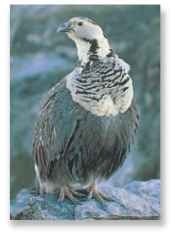
NARROW ESCAPE
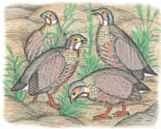
Feeding under cover…
Four snowcocks feed on grass seed heads in a hollow surrounded by rocks, which provide partial cover from nearby predators.
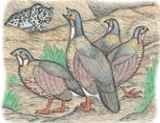
Alarm warning…
One of the birds spots a snow leopard. It stands in an upright position, calling out a warning to the others of impending danger.
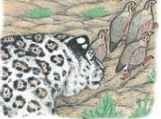
Run for your lives…
Grazing snowcocks scramble up a rocky slope in an attempt to put a safe distance between them and the stalking snow leopard.

Fly away home
As the snow leopard closes in and it appears hopeless for the birds, the snowcocks surprise the big cat as they disperse into flight.
FOOD & FEEDING
The Himalayan snowcock begins its day by descending in the morning from its mountain-top home to seek a drink of water at ground level. As the day warms up, the bird begins its slow ascent, usually in a party of 3-5 birds; it feeds on roots, tubers, berries, green vegetable matter, grass and seeds that it digs up with its stout bill. The bird also swallows a great deal of grit, which is used in the muscular part of the stomach (gizzard) to help grind the tough plant parts that the snowcock eats. The grit is usually retained in the gizzard, while the rest of the food continues its passage through the digestive tract. While on the ground, the Himalayan snowcock uses its powerful feet to scratch for buried insects and bulbous roots that grow on the slopes. The bird is a noisy eater and continually clucks as it feeds; the clucks change to cackles if danger is encountered. During the winter, the snowcock forages for vegetable material not covered by snow.
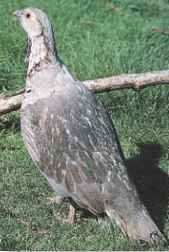
A Grassy glory Seeding grass heads are a staple of the Himalayan snowcock’s diet.
The Himalayan snowcock emits a strong and disgusting stench within a few hours after being killed.
When it is quickly and properly cleaned, Himalayan snowcock meat is said to have both an excellent flavor and texture.
CONSERVATION
The Himalayan snowcock is currently not threatened, but its limited range poses a potential threat to its continued success. Although the snowcock is hunted throughout its range, its roosts are fairly inaccessible to most inexperienced hunters because of the high altitudes.
PROFILE
Himalayan Snowcock
The Himalayan snowcock is a stout gamebird with strong legs and feet designed to get a good grip on steep, rocky mountainsides.
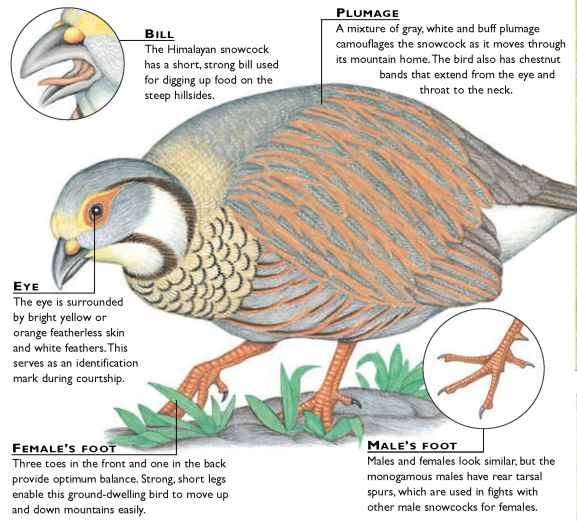
CREATURE COMPARISONS
The Tibetan snowcock (Tetraogallus tibetanus), at 21″, is slightly smaller than the Himalayan snowcock. Its plumage is very similar to the Himalayan’s, with some differences in the amount of buff, white and gray streaking on the upperparts; it also lacks the chestnut bands on the head. Like the Himalayan snowcock, this Tibetan neighbor inhabits the mountain slopes of China, but at higher, more northern elevations, including Tibet; in fact, the Tibetan snowcock lives at the highest elevation of any bird, at up to 10,000′. Both species’ calls range from a clucking sound to a whistle that echoes through the mountains.
Tibetan snowcock Himalayan snowcock
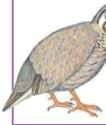
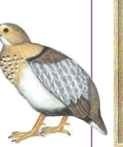
| VITAL STATISTICS | |
| Weight | 4-6 lbs. |
| Length | 22-28″ |
| Sexual Maturity | About 2 years |
| Breeding Season . | April-June |
| Number of Eggs j | 5-10 |
| Incubation Period | 27-31 days |
| Fledging Period | , Unknown |
| Breeding Up to 1 year Interval | |
| Typical Diet | Roots, tubers, green plants, berries and seeds |
| Lifespan | Unknown |
RELATED SPECIES
• The Himalayan snowcock is I of 5 species in the genus Tetraogallus; all are found in Asia, including the Tibetan snowcock, T. tibetanus and a subspecies, the Central Tibetan snowcock, T. t. centralis. There are about 174 species in the Phasianidae family, which includes quails, partridges, pheasants, spur fowls, francolins and peafowls.
